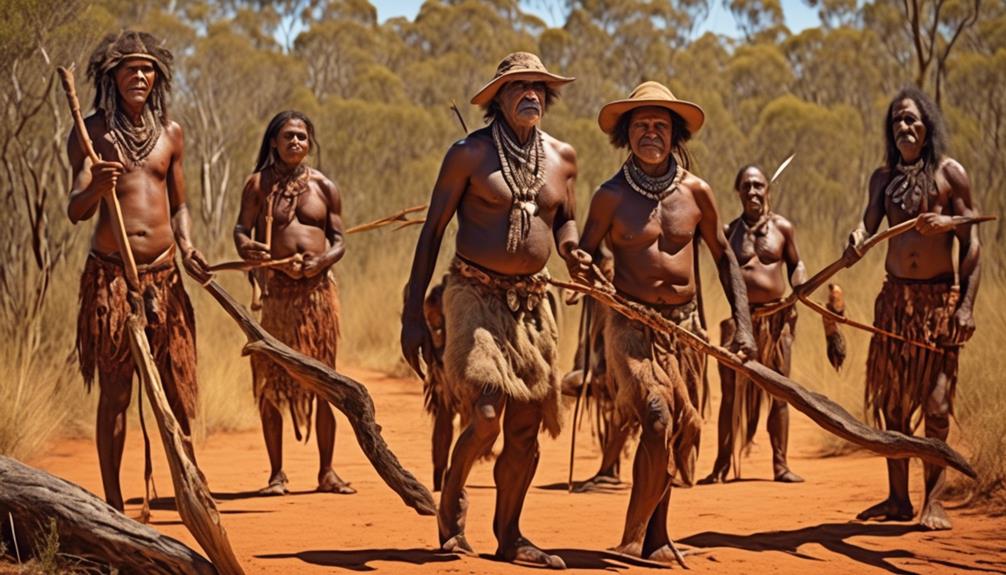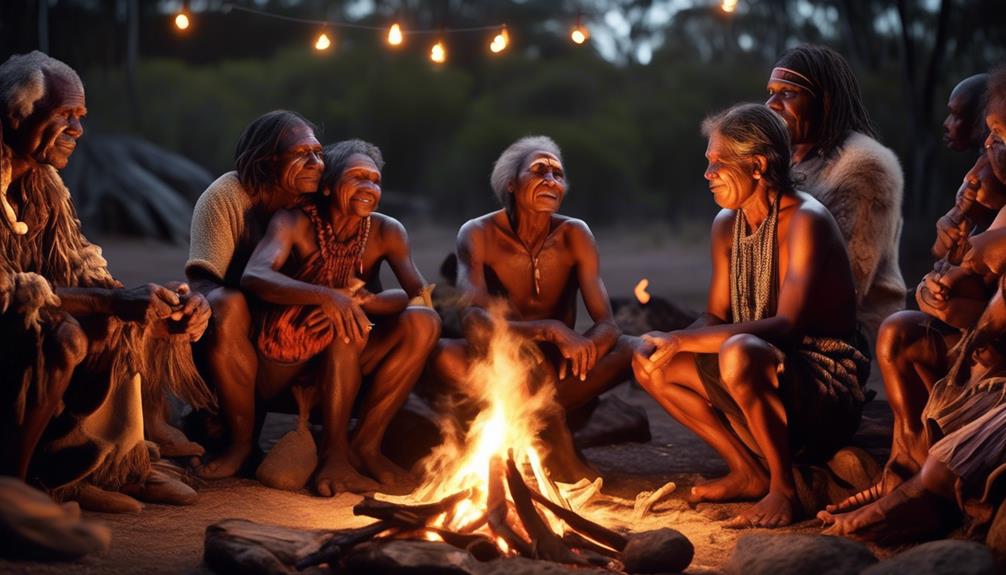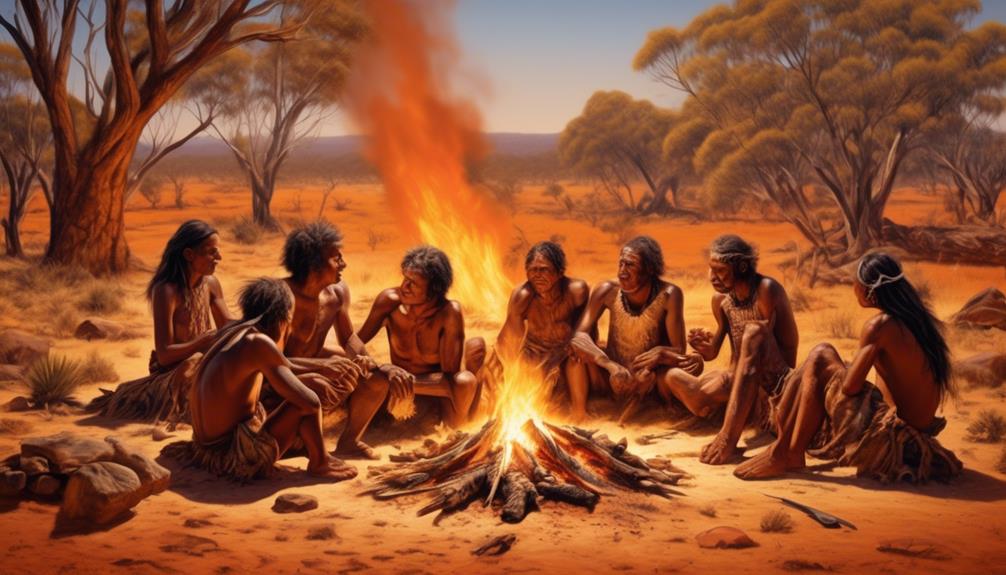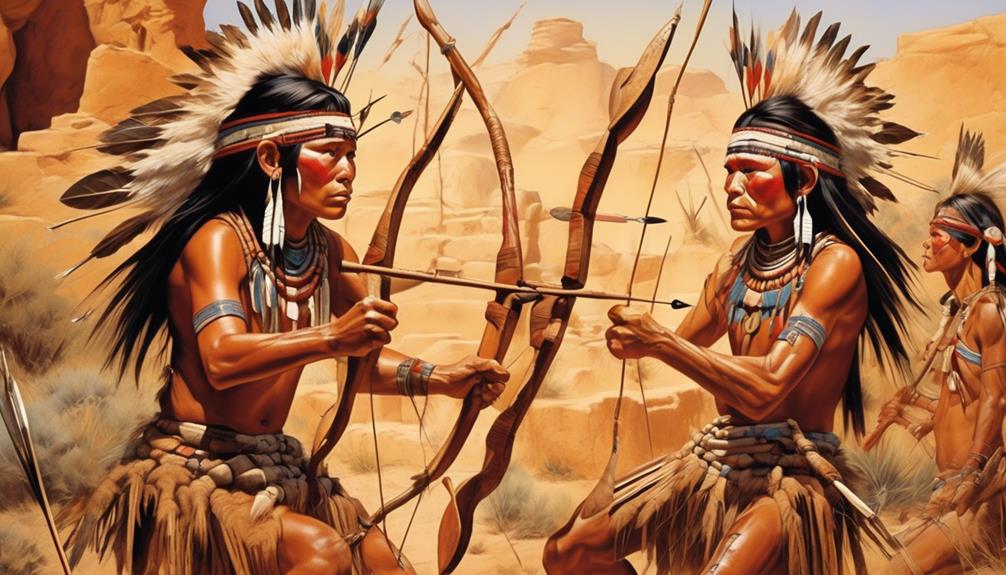For decades, researchers and historians have been intrigued by how Indigenous Australians managed to not just survive, but thrive in some of the harshest landscapes on Earth.
The resilience and adaptability of this ancient culture have fascinated many, and the reasons behind their survival are as complex as they are compelling.
As we explore the deep cultural connection to the land, resourceful traditional practices, adaptation to environmental changes, strong community bonds, and resilience in the face of adversity, we begin to uncover the remarkable story of the Aboriginal Australians and the factors that contributed to their survival against all odds.
Key Takeaways
- Cultural connection to land and environment: The Aboriginal Australians' spiritual and ancestral bond to the land, embedded in their traditions, stories, and rituals, played a significant role in their survival.
- Resourceful traditional practices: The Aboriginal Australians' deep understanding of ecological systems, intricate knowledge of plant and animal resources, and sustainable living practices passed down through generations contributed to their ability to survive and preserve natural resources.
- Adaptation to environmental changes: The Aboriginal Australians' sustainable land management practices, nomadic lifestyle, cultural knowledge transmission, and ability to adapt to changing conditions allowed them to thrive in diverse ecosystems and navigate environmental changes.
- Strong community bonds: Mutual aid, resource sharing, interconnected kinship networks, collective responsibility, and collaborative child-rearing practices fostered unity and resilience within Aboriginal communities, enabling them to overcome adversity and support each other's welfare.
Deep Cultural Connection to Land
Why do Aboriginal Australians have such a deep cultural connection to their land, and how does this connection impact their survival and well-being?
The profound cultural connection of Aboriginal Australians to their land stems from a deep-rooted spiritual and ancestral bond. This connection is embedded in their traditions, stories, and rituals, shaping their identity and worldview. The land isn't merely a physical space but a living entity, providing sustenance, shelter, and spiritual nourishment.
This cultural preservation is crucial for the well-being of Aboriginal communities as it instills a sense of belonging, pride, and resilience. It fosters a holistic approach to life, integrating environmental sustainability with cultural practices. This connection to the land has enabled Aboriginal Australians to adapt and thrive within diverse ecosystems for thousands of years.
Resourceful Traditional Practices

Resourceful traditional practices, such as intricate knowledge of plant and animal resources, have been instrumental in the survival and resilience of Aboriginal Australian communities for centuries. Traditional knowledge passed down through generations has equipped Aboriginal Australians with the skills to live in harmony with the land, ensuring sustainable living and the preservation of natural resources. Indigenous practices, deeply rooted in a profound understanding of the environment, have allowed for the utilization of resources without depleting them. This sustainable approach to living has enabled Aboriginal Australians to thrive in diverse and often harsh landscapes, showcasing their adaptability and ingenuity.
The traditional practices of Aboriginal Australians exemplify a deep understanding of the ecological systems and the interconnectedness of all living things. These practices encompass not only the practical uses of natural resources but also the spiritual and cultural significance attached to them. This holistic approach to resource management underscores the wisdom and foresight embedded in Aboriginal traditions, offering valuable insights for modern societies grappling with environmental sustainability.
Adaptation to Environmental Changes
Adapting to environmental changes requires harnessing the resourceful traditional practices of Aboriginal Australians to navigate the evolving ecological landscape. The survival strategies of the Aboriginal Australians reflect their deep understanding of environmental evolution and their ability to adapt.
- Sustainable Land Management: The Aboriginal Australians have a long history of sustainable land management practices, such as controlled burning, to maintain the health of the land and promote biodiversity. These practices demonstrate a sophisticated understanding of the interconnectedness of ecosystems and the need to adapt to changing environmental conditions.
- Mobility and Flexibility: The nomadic lifestyle of many Aboriginal groups allowed for increased mobility and flexibility in response to environmental changes. This enabled them to move to areas with more abundant resources or adapt their hunting and gathering practices as needed.
- Cultural Knowledge Transmission: The transmission of cultural knowledge from generation to generation has ensured the preservation of survival strategies and adaptive practices. This intergenerational transfer of knowledge has been crucial in enabling Aboriginal communities to navigate and adapt to environmental changes over time.
These survival strategies and adaptive practices highlight the resilience and ingenuity of the Aboriginal Australians in the face of environmental challenges.
Strong Community Bonds

Drawing on the deep-rooted cultural traditions, Aboriginal Australian communities have fostered resilient social bonds that have withstood the test of time and continue to be a cornerstone of their survival strategies. The strong community support and social cohesion within Aboriginal Australian groups have played a pivotal role in their ability to adapt and thrive in the face of various challenges. These bonds are deeply ingrained in their cultural practices and have been instrumental in providing a sense of belonging, security, and shared identity, which are essential for individual and collective well-being.
| Community Support | Social Cohesion |
|---|---|
| Mutual aid and resource sharing | Rituals and ceremonies fostering unity |
| Interconnected kinship networks | Consensus-based decision-making processes |
| Collective responsibility for welfare of all | Storytelling traditions preserving history |
| Collaborative child-rearing practices | Inter-generational knowledge transmission |
| Rituals reinforcing communal values and solidarity | Ceremonial gatherings promoting togetherness |
These community bonds have not only provided emotional and practical assistance during times of need but have also contributed to the preservation of cultural heritage, knowledge, and wisdom. The deep sense of interconnectedness and shared responsibility has allowed Aboriginal Australian communities to endure and flourish, serving as a testament to the strength of their social fabric.
Resilience in the Face of Adversity
Amidst the myriad challenges faced by Aboriginal Australian communities, their resilience has been a defining factor in their ability to overcome adversity and thrive. The mental toughness exhibited by these communities in the face of historical trauma has been remarkable.
Their resilience can be attributed to several key factors:
- Strong Cultural Identity: Despite the impact of historical trauma, Aboriginal Australian communities have maintained a strong sense of cultural identity, which has served as a source of resilience. The preservation of traditional knowledge, languages, and cultural practices has provided a foundation for resilience in the face of adversity.
- Community Support Systems: The interconnectedness within Aboriginal Australian communities has played a crucial role in fostering resilience. Social support, mutual aid, and collective problem-solving have been instrumental in helping individuals and communities withstand and overcome challenges.
- Adaptability and Innovation: Aboriginal Australian communities have demonstrated a remarkable ability to adapt to changing circumstances and innovate new solutions. This adaptability has allowed them to navigate challenges such as displacement, loss of land, and social injustices.
The resilience exhibited by Aboriginal Australian communities in the face of historical trauma serves as a powerful example of overcoming adversity through mental toughness, cultural strength, and community resilience.
Frequently Asked Questions
What Role Did Spiritual Beliefs and Practices Play in the Survival of Aboriginal Australians?
Spiritual practices in Aboriginal Australian culture played a crucial role in their survival. These practices fostered cultural resilience and passed down traditional knowledge through storytelling traditions.
By connecting with the land and their ancestors, Aboriginal Australians maintained a strong sense of identity and community. These beliefs provided a framework for decision-making and problem-solving, promoting harmony and sustainability within their environment.
This deep spiritual connection contributed to their ability to adapt and thrive in challenging circumstances.
How Have Traditional Storytelling and Oral Histories Contributed to the Resilience of Aboriginal Communities?
Oral traditions have been crucial in preserving Aboriginal cultural resilience. Statistics show that over 250 Indigenous languages are still spoken in Australia, highlighting the enduring impact of storytelling and oral histories.
These traditions have passed down knowledge, values, and survival skills through generations, fostering a strong sense of identity and connection to the land.
This has contributed significantly to the resilience of Aboriginal communities, providing a rich tapestry of resilience and strength.
What Specific Traditional Knowledge and Skills Have Been Crucial for the Survival of Aboriginal Australians?
Traditional knowledge, survival skills, and cultural practices have been crucial for the survival of Aboriginal Australians. Our spiritual beliefs, oral histories, and storytelling have sustained our cultural identity in the face of colonization impact and government policy.
These elements have fostered community resilience, enabling us to navigate and adapt to changing circumstances. By preserving and passing down these traditions, we continue to draw strength and resilience from our heritage.
How Have Aboriginal Communities Maintained Their Cultural Identity in the Face of Colonization and Modernization?
Maintaining our cultural identity amidst colonization and modernization has required spiritual resilience and cultural adaptation.
Despite challenges, Aboriginal communities have upheld traditions through storytelling, art, and language preservation.
Our connection to the land and sacred sites has been pivotal in preserving our cultural identity.
Additionally, community-led initiatives and advocacy have played a crucial role in promoting and safeguarding our cultural practices.
It's through these efforts that our cultural identity continues to thrive.
What Impact Has Government Policy and Intervention Had on the Survival and Resilience of Aboriginal Australians?
Government policy and intervention have significantly impacted the survival and resilience of Aboriginal Australians. These actions have influenced cultural resilience, spiritual beliefs, traditional knowledge, storytelling, and cultural identity.
Colonization and modernization further shaped these effects. Understanding the historical and contemporary implications of these policies is crucial for comprehending the challenges faced by Aboriginal communities.
We see the enduring impact of government actions on the survival and resilience of Aboriginal Australians.
Conclusion
In conclusion, the Aboriginal Australians survived through their deep cultural connection to the land, resourceful traditional practices, adaptation to environmental changes, strong community bonds, and resilience in the face of adversity.
Their ability to maintain a harmonious relationship with the environment, utilize traditional knowledge, and support each other through challenges has allowed them to thrive for thousands of years.
Their survival serves as a testament to the strength and resilience of indigenous cultures worldwide.
Mary is a passionate writer who brings creativity and a fresh perspective to our team. Her words have the power to captivate and inspire, making her an essential contributor to our content. Mary’s commitment to storytelling and dedication to promoting Indigenous culture ensures that her work touches the hearts of our readers. We’re fortunate to have her as part of our team.










